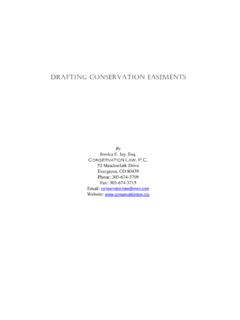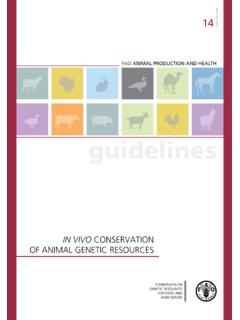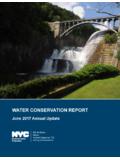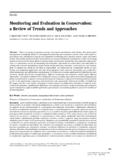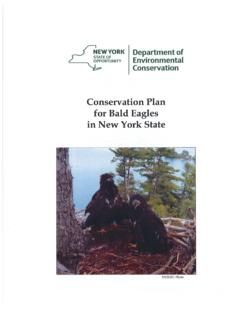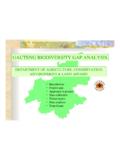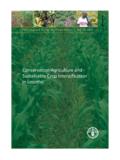Transcription of ConservATion opTions ConneCTiCuT fArMLAnd
1 ConservATionopTionsforConneCTiCuTfArMLAn dA Guide for Landowners, Land Trusts & MunicipalitiesWORkING TOGEThER FOR fArMLAnd PRESERvATION IN CONNECTICUTC onnecticut Department of ConneCTiCuT Department of Agriculture sFarmland Preservation Program was establishedin 1978. Its expert staff works hard to protectthe best fArMLAnd soils in the state to maintainand preserve agricultural land for the future. As of December2009, the CT fArMLAnd Preservation Program had preserved over35,570 acres on 265 farms, the majority of protected fArMLAnd inthe Natural ResourcesConservation Service (NRCS) is the primary federalagency working to protect natural resources on privately ownedland by providing technical and financial assistance to plan andimplement ConservATion stewardship practices.
2 NRCS also admin-isters the Farm and Ranch Lands Protection Program (FRPP),which provides funding to purchase ConservATion easements onfarmland. The agency provides information about soils and othernatural resources to communities for land use fArMLAnd Trust (CFT) The mission of CFT is to permanently protectConnecticut s working fArMLAnd ; it is the only private statewide land trust dedicated to protecting ConneCTiCuT s fArMLAnd . CFT s experienced staff provides technical assistance and outreach to agricultural land-owners interested in fArMLAnd preservation. CFT is equipped to negotiate and hold agricultural ConservATion easements and provide innovative, flexible and timely solutions to farm ownersacross the state.
3 Through partnerships with towns, local landtrusts, ConservATion organizations, individual donors, and stateand federal agencies, CFT is able to leverage public and privatefunds and to provide landowners with ConservATion opTions that might not otherwise exist. As of February 2010, CFT held ConservATion easements on 20 farms totaling 1,766 acres in fArMLAnd Trust (AFT) AFT is the only national non- profit membership organization dedicated to helping America s farmers and ranchers protect theirland and produce a healthier environment. Founded in 1980, AFTis the nation s leading advocate for healthy farms, healthy foodand a healthy environment.
4 Its work has helped save more thanthree million acres of farm and ranch land from development andhas encouraged thousands of communities around the country toplan proactively for agriculture, helping to sustain local farms andthe food and benefits they provide. CFT and AFT are not affiliated,although the two organizations work closely Lands Alliance (WLA) project of AFT, the WLA is a coalition of ConneCTiCuT organizations, citizens and businesses working to raiseawareness of the need to save ConneCTiCuT s valuable and vanish-ing fArMLAnd . WLA members reflect the diversity of people whoshare a concern about fArMLAnd preservation in ConneCTiCuT farmers, planners, conservationists, anti-hunger advocates, historicpreservationists, chefs and food retailers.
5 WLA encourages anyonewho cares about the future of ConneCTiCuT s family farms to joinits efforts to educate policy leaders about the importance and benefits of fArMLAnd protection. WLA is yourvoice for farmlandpreservation in ConneCTiCuT . Sign up online to receive updates andalerts about fArMLAnd preservation policy in ConservATion Easements1 Frequently Asked Questions2 Estate Planning and Farm Transfer4 Tax Considerations5 fArMLAnd Protection Programs in Connecticut7 Can I Protect My Forestland Too? 10 Role for Municipalities and Communities11 Role for Land Trusts13 Additional Funding Available14 State Policies17 Contact Information and Resources18 Funding for ConservATion opTions for ConneCTiCuT Farmlandwas provided by the ConneCTiCuT Department of also to the following individuals who contributed revisions to this publication: Joseph Bonelli, Bonnie Burr, Phil Chester, Joseph Dippel, John Guszkowski, Eric Hammerling,Kip Kolesinskas, Elisabeth Moore, Joan Nichols, Steve Reviczky,Henry Talmage and Amy Zeiner.
6 The following AFT staff assisted in the guide s writing, editing and design: Ben Bowell,Cris Coffin, Jiff Martin and Doris obtain copies of this publication, contact the Connecticutfield office of American fArMLAnd Trust at (860) 683 4230 orvisit of ContentsConnecticut is home to several organizations that work collaboratively on fArMLAnd preservation. Each of these public agencies and organizations plays a vital role in saving ConneCTiCuT s valuable and vanishing opTions for Connecticut1 Agriculture is deeply rooted in generations, farms and farmers have been a cornerstone of communities throughout the state, providing: a bounty of fresh food and produce local jobs and tax revenues pastoral views and recreational opportunities wildlife habitat clean air and waterConnecticut s agriculture is being uprooted, as farms give way to subdivisions and suburban sprawl has made farming alogistical and economic challenge.
7 The escalating loss of fArMLAnd threatens not just the viability of an industry but also the state s rural legacy and opTions for ConneCTiCuT Farmlandaims to help landowners, land trusts and municipalities navigate thesometimes confusing array of public programs available to protect and steward their fArMLAnd . The guide also provides an overview of estate planning opTions and tax considerations. In ConneCTiCuT , the most common fArMLAnd protectiontool is the agricultural ConservATion ConservATion easementis a deed restriction or deedcovenant that landowners voluntarily place on part or allof their land. The easement limits development in order to protect the land s natural resources.
8 An agriculturalconservation easementis an easement specifically designedfor agricultural land. Agricultural ConservATion easements can be donated, usually to a nonprofit land trust, or sold to a publicagency or qualified ConservATion organization through a purchase of development rights(PDR) program. ConneCTiCuT s PDR program, administered by theDepartment of Agriculture, is called the CT FarmlandPreservation Program. The federal program that providescost-share assistance to states, towns and land trusts tohelp fund the purchase of development rights is known asthe Farm and Ranch Lands Protection Program (FRPP).More information about these two programs can be foundon pages 7 and 8.
9 Landowners can also combine the sale and donation of anagricultural ConservATion easement through a bargain a bargain sale, a landowner sells an easement atless than its fair market value, taking a charitable deduc-tion on the donated portion of the easement. Whether to donate or to sell an easement, or how much of a donation to make as part of a bargain sale, is often a complex decision that is influenced by a landowner sincome level, tax bracket, cost basis in the property, business and/or personal objectives, and the availability of town, state or federal funding for the purchase of development rights. Agricultural ConservATion Sweetnam photoConservation opTions for Connecticut2 The following answers to frequently asked questionsabout easements should help landowners understandsome of the legal, financial and practical implications of placing an easement on their property.
10 What is an agricultural ConservATion easement? An agricultural ConservATion easement is a deed restriction or deed covenant that landowners donateor are paid to place on their property. Typically, an easement permanently restricts residen-tial, industrial and non-agricultural commercial development of the property. The landowner retainsownership of the land, and the easement is held by theentity to which the easement has been donated or entity that holds the easement is responsible forensuring that the terms of the easement are easements are perpetual; those that are not aregenerally referred to as term should a landowner donate or sell an agricultural ConservATion easement?











